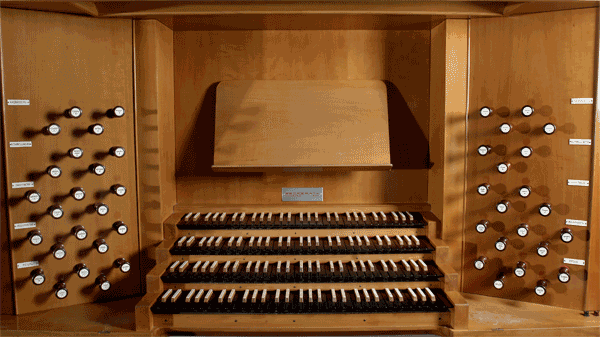This organ has 3,467 pipes arrayed in 65 ranks. These ranks are
encased in 5 divisions, with a keyboard for each division:
the Pedal division is encased in the two towers;
the Hauptwerk is the chief (haupt) manual division;
the Rückpositiv is at the organist's back (rück);
the Kronpositiv is the crown (kron); and
the Schwellwerk has shutters to reduce or increase (schwell) volume.
Ranks of pipes are engaged by pulling stop(knob)s at the console.
A stop typically controls 1 rank of pipes, with 1 pipe per key:
61 pipes (5 octaves) for stops in the manual divisions, and
32 pipes (22 octaves) for Pedal stops.
Some stops control 2 or more ranks and provide either bite or brilliance.
This organ is entirely mechanical except for a 1hp motor that supplies the wind.
The specifications of this organ are given below. Here's a translation:
The name of the stop indicates which of four families it belongs to:
principals: prinzipals, oktaves, terzian, mixtures (III, IV, VI).
flutes: flötes, subbass, nachthorn, quintadenas, gedackts, nasats, sesquialtera.
reeds: trompets, posaune (trombone), dulzian, bärpfeife,
krummhorn, oboe.
strings: gemshorns.
The number indicates whether a rank sounds at the unison (8') another pitch.
Some ranks sound 1 octave below the unison (16').
Many ranks sound 1 or 2 or even 3 octaves above the unison (4', 2', 1').
Two stops (2-2/3' and 1-1/3') add color by sounding at other overtones.
A Roman numeral indicates 2 or more ranks.
Two-rank stops (II) add bite; stops with more ranks (III, IV, VI) add brilliance.
Couplers allow keyboards to be combined for greater variety or volume.
The Kronpositiv, Schwellwerk, and Rückpositiv can be coupled to the Hauptwerk.
The Schwellwerk and Rückpositiv can be coupled to the Pedal.
Tremulants can be used to add a quavering quality.
A cymbalstern is a set of bells that provides sparkle.
|







